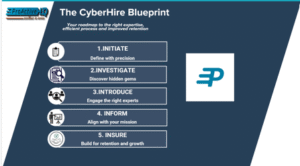Ask any junior cybersecurity professional where they want to be in 10 years, and chances are you’ll hear:
“I want to be a CISO.”
But getting from Security Analyst to Chief Information Security Officer isn’t just about climbing a ladder — it’s about navigating a strategic roadmap.
So what does that journey look like?
And what should aspiring cyber leaders focus on at each stage?
Let’s break it down:
Stage 1: Analyst (SOC / GRC / Risk / IAM / Threat Intel)
This is your foundation — learning to detect, respond, and understand the threat landscape.
Focus on:
- Hands-on experience with tools (SIEM, EDR, vulnerability scanners)
- Incident response workflows
- Building a security mindset
Goal: Master the fundamentals and show you can operate under pressure.
Stage 2: Engineer / Specialist / Consultant
Now you’re applying knowledge to design, improve, or advise on specific areas of security (cloud, network, application, identity).
Focus on:
- Deepening technical or compliance expertise
- Taking ownership of small projects or domains
- Building cross-functional communication skills
Goal: Be known as the go-to expert in your area — and someone people trust.
Stage 3: Security Architect / Lead / Manager
Time to shift from doing to leading and influencing.
Focus on:
- Designing scalable, risk-based security solutions
- Managing teams or programs
- Aligning security with business goals
Goal: Bridge the gap between strategy and execution. Learn to speak “business” as well as “tech.”
Stage 4: Director / Head of Security / Deputy CISO
This is where visibility increases — and so does accountability.
Focus on:
- Leading security functions end-to-end
- Shaping governance, risk, and compliance
- Presenting risk to boards, execs, and regulators
- Managing budgets and influencing org-wide decisions
Goal: Develop an executive presence — and prove you can lead security at scale.
Stage 5: CISO (Chief Information Security Officer)
This is more than a title — it’s a business-critical leadership role.
Responsibilities:
- Shaping enterprise-wide security strategy
- Navigating regulatory landscapes
- Managing incidents and reputational risk
- Building and retaining top cyber talent
- Collaborating with the board, CIO, legal, and beyond
CISO = Risk leader. Strategist. Communicator. Culture shaper.
Final Thought: It’s a Journey, Not a Shortcut
Not every great analyst becomes a CISO — and not every CISO was the most technical person in the room.
To rise through the ranks:
✔ Build technical depth early
✔ Layer in leadership, strategy, and business skills
✔ Learn continuously — and stay humble
Your pathway won’t look exactly like anyone else’s — and that’s the beauty of a career in cybersecurity.
—
What stage are you in — and what advice would you give to those coming up behind you? Let’s grow the next generation of cyber leaders together




